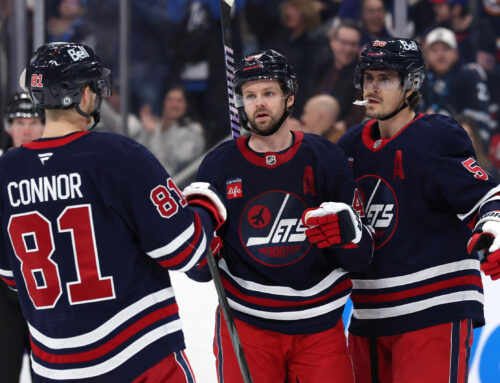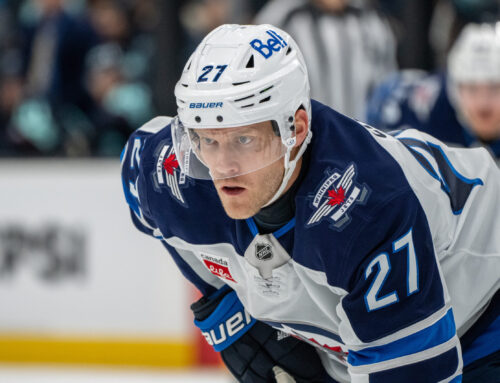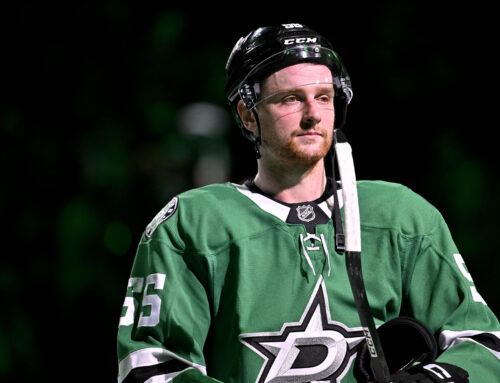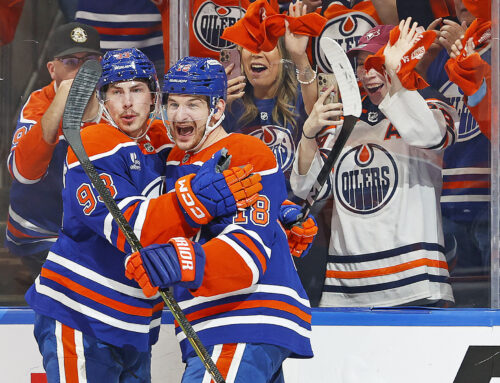
Taking an early look at nine key Western Conference line combos/defense duos so far.
Line Combos of Note
There are always some line combinations that bear watching at the beginning of every season, combinations that if they hold could foretell a changing in the fortunes of a specific player. It could mean that a player has moved up the depth chart, or gained the coach’s trust. With each interesting early-season line combination it is important to remember that different combinations, in whole or in part, have varying amounts of slack given to them by the coach. A rookie playing on a top line, on a team hoping to contend, will not last as long as a similar rookie on a rebuilding team, if each are similarly lacking production.
Furthermore, it is necessary to pay attention to a coach’s tendency to mix up his lines. While all coaches change their lines, some have a greater tendency to throw their lines into a blender at the slightest sign of any struggle. John Totorella and Daryl Sutter are good examples of such coaches. Tortorella has in fact already played matchmaker with his lines after one game because Columbus struggled in their opener. That is the danger inherent in basing any value off line combinations, other than those well-known combos/duos, the propensity for them to be short lived.
Positives
Mikhail Grigorenko–Matt Duchene–Carl Soderberg – Colorado
This line shows that Jared Bednar is going to consolidate his best players into his top six in order get the tempo he wants from his best players. The two things that could change this are the return of Mikko Rantanen and the failure of the bottom six to contribute. The first factor is more likely to rear its head down the line after Mikko Rantanen has come back from injury and if Grigorenko cannot keep up with Duchene and Soderberg. The second factor pertains to whether a bottom six of Gabriel Bourque, Rene Bourque, Blake Comeau, Joe Colborne, Andreas Martinsen provide adequate depth to allow Bednar to keep his loaded top six intact. If the loaded top six remains intact it bodes very well for Soderberg and Grigorenko. In the Avs’ only game the Soderberg line was the most used forward line at even strength as the only three forwards to play more than 13 minutes outside of any special teams use. Furthermore, each of the three forwards were amongst the Avs’ leaders in powerplay time with Soderberg and Duchene getting time with Jarome Iginla and Blake Comeau while Grigorenko played with Gabriel Landeskog, Nathan MacKinnon and Joe Colborne on a unit that struck twice. This line will not necessarily help Duchene but it will help Grigorenko and Soderberg, especially Grigorenko.
Patrick Sharp–Jason Spezza–Jiri Hudler – Dallas
The departure of Valeri Nichushkin to the KHL and the injuries to Cody Eakin and Mattias Janmark forced Lindy Ruff to condense the offensive talent of a normally loaded Dallas lineup into the top six. The big winner is Patrick Eaves as he ends up with Jamie Benn and Tyler Seguin for as long as Sharp is on the second line. This configuration though should lessen the difference between playing on the Stars’ first line versus their second line. For Sharp 70% of his production last year came when he was on the ice with Jamie Benn, even though only 60% of his time on the ice was with Benn. Conversely he got 12% of his production while with Spezza while spending 13% of his ice time with Spezza. That is less production than he had in the 9% of his ice time he played with Cody Eakin. That suggests that his time spent on a line with Spezza was more of a hindrance to his production than anything else, which should change this year. In all, this means that the Stars should have a very dangerous and productive second line, which is a nice change as the Stars’ best lines, those averaging more than three goals per 60 minutes, are heavily dominated by Benn and Seguin.
Nashville
Filip Forsberg–Ryan Johansen-Kevin Fiala
It is not clear just how much this line actually plays together as both Johansen and Forsberg have played at least 30% of the Predators even strength minutes whereas Fiala is under 20%. Furthermore, Johansen and Forsberg have thus far gotten 70% of the Predators’ power play time whereas Fiala has not seen the ice on the power play. Johansen and Forsberg should both get 70 points this year regardless of whether they play together at even strength. This combination if it works could give one of them a shot at 80 points but it is unlikely that it has a big effect for either of them. For Fiala it could be huge as he as the potential to be a big offensive piece for Nashville. Fiala is a great example of a player who is in danger of his losing his prime spot in the top six on a deep contender if he does not produce results in short order. While his speed and ability may allow him slightly longer leash under coach Peter Laviolette, this is not a team that will bank on potential this year.
Anaheim
With Hampus Lindholm still sitting on the sidelines as a restricted free agent the Ducks will rely heavily on Cam Fowler and Sami Vatanen. That will be especially the case as long as they are paired together. This will help both of these defensemen as long as they remain together. Their usage has not changed much at all except that they are each seeing three minutes more per game than they were last year. Fowler has seen a bigger jump in the percentage of the Ducks’ power play time he sees, however while he is on for 65% of the Ducks’ power play time this year he was at 60% last year as well. Both Vatanen and Fowler have seen four minutes of power play time per game this year, although that is probably something of an outlier as Fowler only played three minutes per game last year and is up close to five minutes this year. Whereas as Vatanen hit 38 point last year Fowler, dragged down by the Bieksa anchor, could not break 30 points. This is the type of usage that could spell breakout for either defenseman, but the effect on Fowler’s value would be much more significant.
Winnipeg
Dustin Byfuglien-Josh Morrissey
The big of the standoff between the Jets and Jacob Trouba is Josh Morrissey. He has yet to see any power play time but played nearly 20 minutes in the Jets’ second game. In a very limited sample he and Byfuglien have the defensemen getting the best offensive minutes, although as the Jets have struggled that does not necessarily mean much. He is however averaging close to six shots per 60 minutes along with a hit per game and half a block per game. As the Trouba situation looks like it will drag well into the season there is real potential for Morrissey to stake his claim on a spot on the Jets’ top defensive pairing.
Negatives
Arizona
Lawson Crouse-Laurent Dauphin-Ryan White
For poolies who were for anything but peripheral contributions form Lawson Crouse this combination does not bode well. Dauphin and White are both players who will be relied upon more for their defensive contributions than anything else. None of this trio has played much with White leading the trio at even strength, while Dauphin almost equaled him overall due to heavy shorthanded minutes. Crouse only saw five minutes of ice time in Arizona’s first game, while the other two saw 10 minutes each. The line as a whole dished out 11 hits in a combined 26 minutes, which speaks to their expected role. It looks like they will be expected to be more of an energy line than a shutdown line as in the Coyotes’ only game they basically saw 60% offensive zone starts, with Crouse not starting a shift in the defensive zone. If this usage holds they might see similar value to Casey Cizikas, Cal Clutterbuck and Matt Martin in their glory days.
Chicago
Marian Hossa–Tyler Motte-Nick Schmaltz
This is bad news for all three members of this line as they were each expected to see time in Chicago’s top six this year at some point. Last year was the first time in while that Hossa spent significant time in the bottom six away from Jonathan Toews. This year it only took one game for Joel Quenneville to bump him down the lineup to make room for Vince Hinostroza. This was previously unthinkable and if this remains the case any hoped of a Hossa rebound this year based on his strong scoring chance and shot numbers will dwindle quickly. For Schmatlz and Motte a spot in the bottom six is equally damaging as a spot in the top six in Chicago is potentially worth more than 40 points. Hossa at least still sees power play time while Schmaltz and Motte must rely solely on their 10 minutes of even-strength ice time. While they do not get buried in the defensive like Kruger’s line the prime offensive minutes still go to Kane’s line primarily and to Toews’ line to a lesser extent. If this holds over the season they will each likely to struggle to get even 20 points.
Minnesota
Jonas Brodin-Christian Folin
There is not a ton to say about this pairing except that it cannot be seen as anything other than the death of Brodin’s fantasy value. In a limited sample he has received decent offensive zone starts but only got 15 minutes of ice time per game. Even worse is that he sees significant short-handed minutes as he has been on the ice for 30% of the Wild’s penalty killing minutes. Furthermore, he has been passed on the Wild’s depth chart both by Jared Spurgeon, Marco Scandella and Matt Dumba at even strength as well as on the power play. This can be seen in how his percentage of the Wild’s overall ice time has fallen from close to 40% through in his first three years to 33% last year and now 25% through the Wild’s first two games this year. He should only be owned in the deepest of leagues and will likely only have future value if he is claimed in the expansion draft.
Remains to be seen
Oliver Ekman-Larsson-Connor Murphy
The pairing itself is not necessarily a negative for Ekman-Larsson (OEL) and is almost certainly a positive for Connor Murphy. There has not been a big change for OEL on the power play but it looks like there could some changes in other areas. It is only one game but OEL look like he will be back to playing a major role on the penalty kill as in the Coyotes sole game this year he was on for 40% of their penalty kill. As long as he continues to get 85-90% of their power play time he should be fine but the increased time on the penalty kill could be a drag on his production this year unless he continues to play 30 minutes per game through out the season. This could have a bigger effect on Connor Murphy as he played close to 25 minutes in the Coyotes’ first game. The fact that he played half of the Coyotes’ penalty kill is not great, neither is falling to under 10% of their power play time, but the general minutes increase is promising especially for a player who has burgeoning multi-category depth potential.
The statistics for this column were drawn from Dobberhockey.com and Corsica.hockey
Put together a team under a salary cap and compete with hundreds of fantasy owners around the world. It's free, and player values move up and down based on demand/ownership. Try DOBBERNOMICS right now!






 MIN
MIN MTL
MTL PHI
PHI COL
COL CHI
CHI ANA
ANA BUF
BUF
